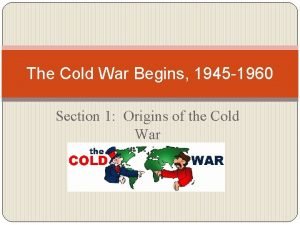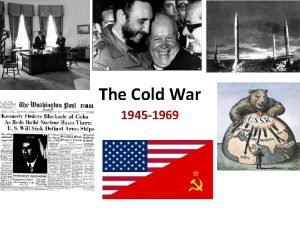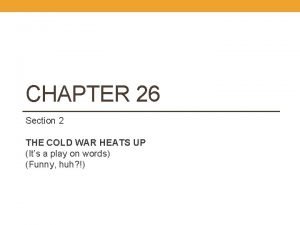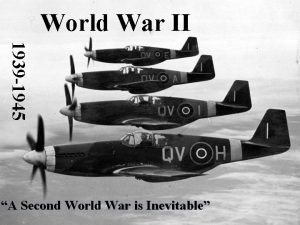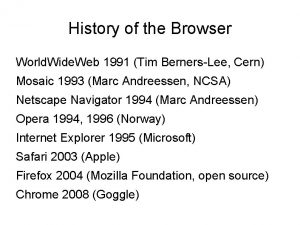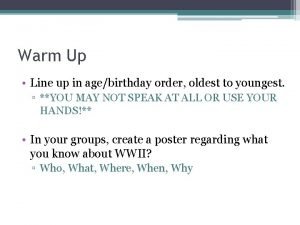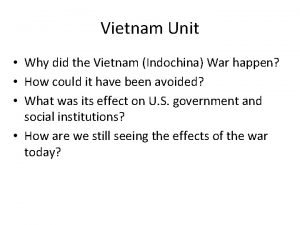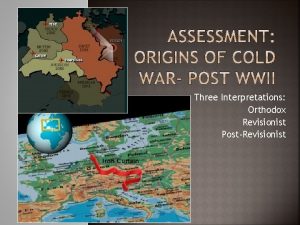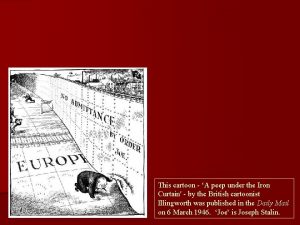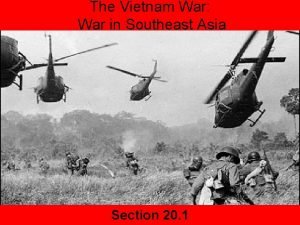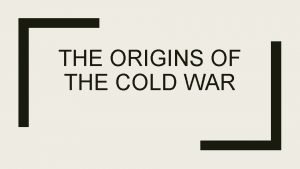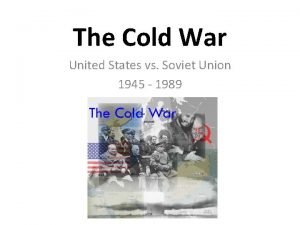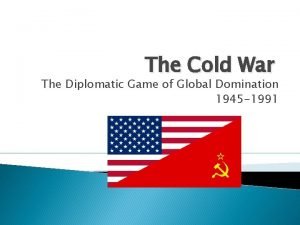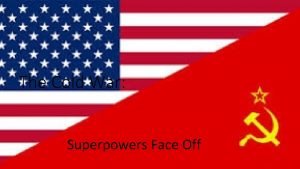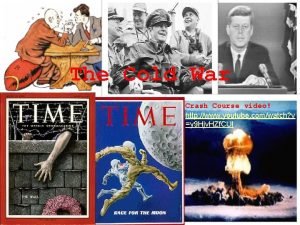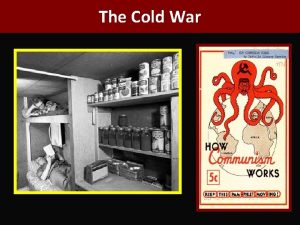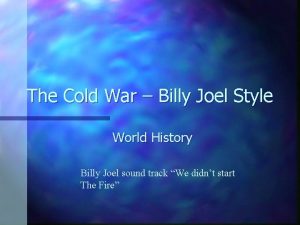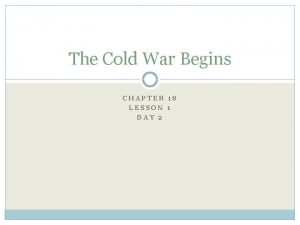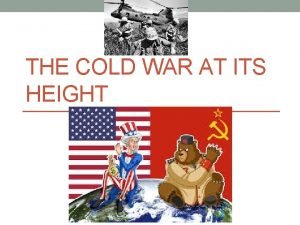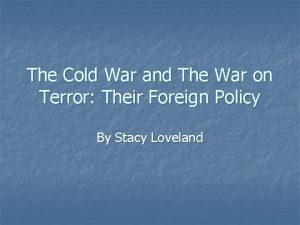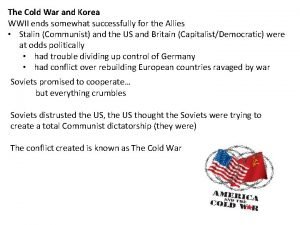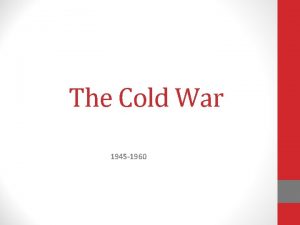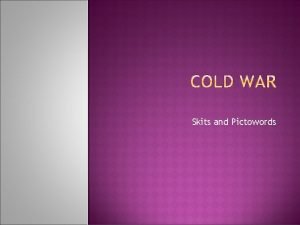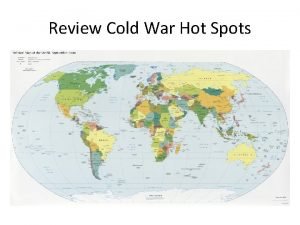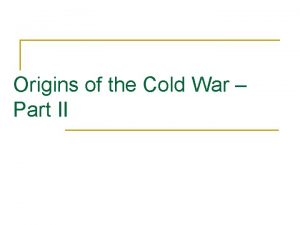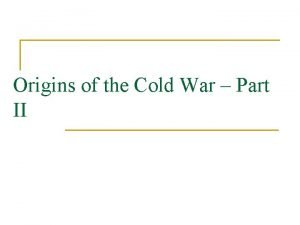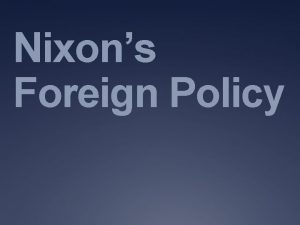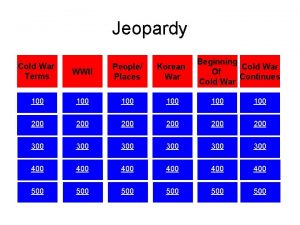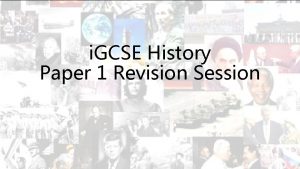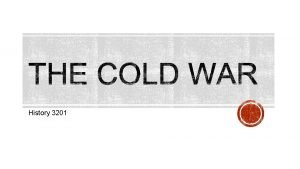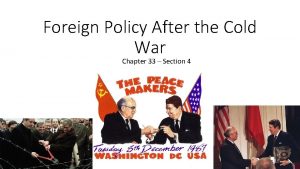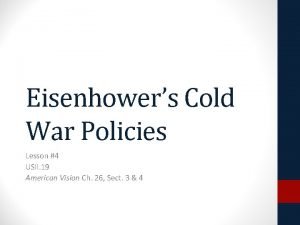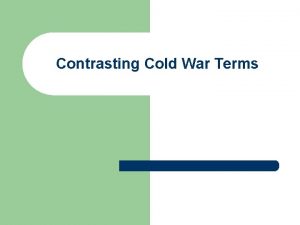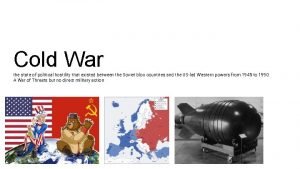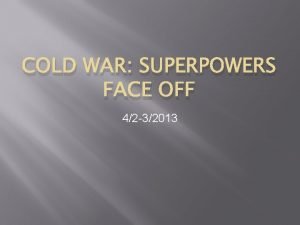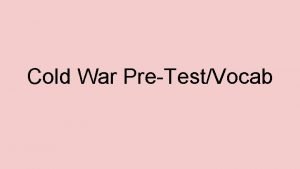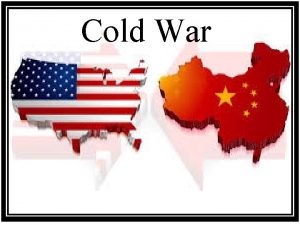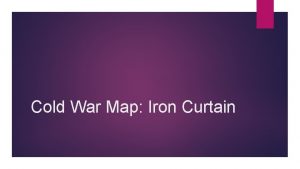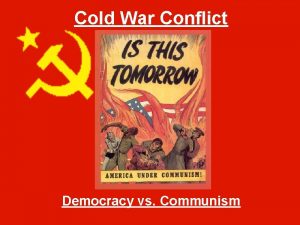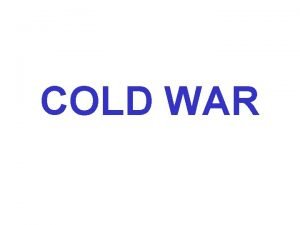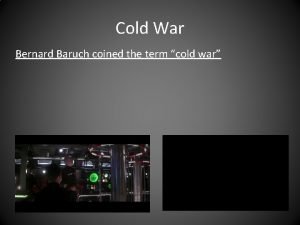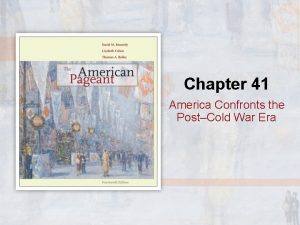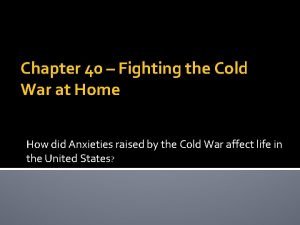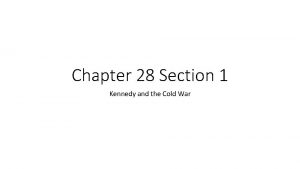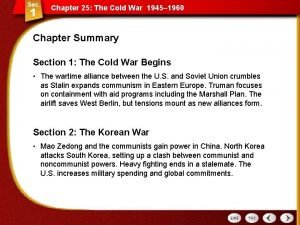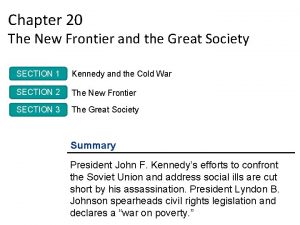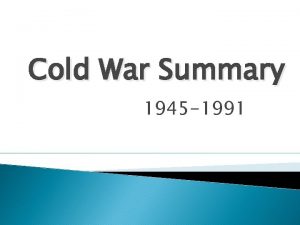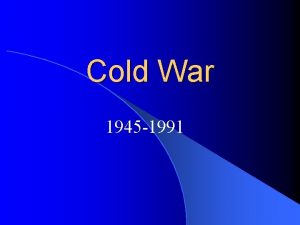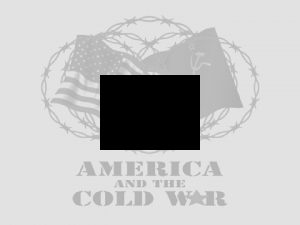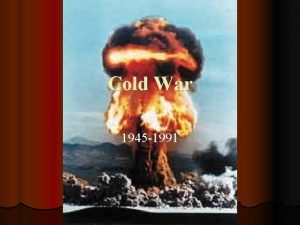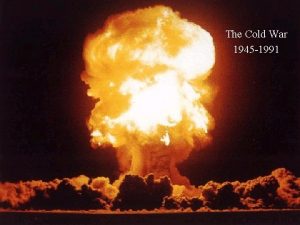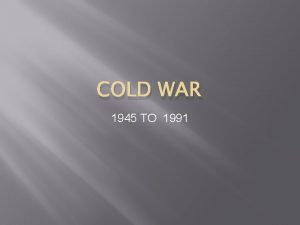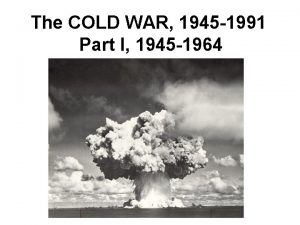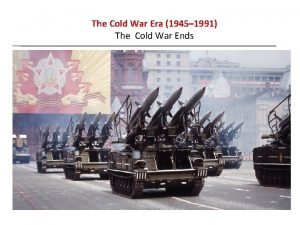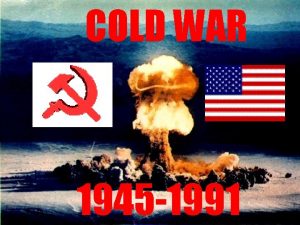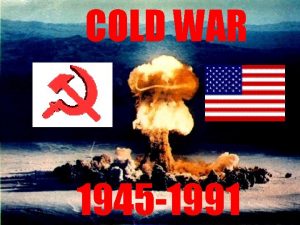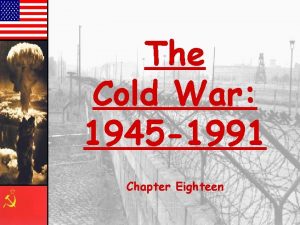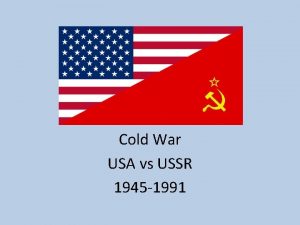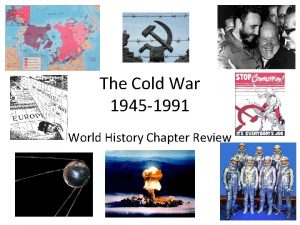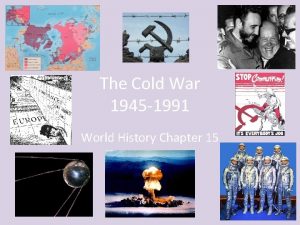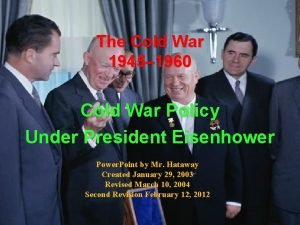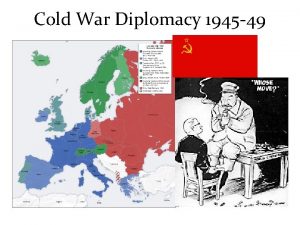The Cold War the World 1945 1991 Formation



















































- Slides: 51

The Cold War & the World 1945 -1991

Formation of the UN § Towards the end of WWII, hopes were high for world peace. § The most visible symbol of this was the creation of the United Nations (UN). § 50 nations met in April. May of 1945 to establish new peace-keeping procedures and rules.

World Superpowers: Dominant world powers with enormous economic and military strength!

THE 5 W’S OF THE COLD WAR

WHO? ? The United States vs. The USSR

WHAT WAS IT? ? A period of “icy tension” between the U. S. and USSR

WHEN WAS IT? ? The decades that followed WWII (1945 -1991)

WHERE WAS IT? ? It was between the United States and the Soviet Union, but it affected the ENTIRE world….

WHY? ? Different political & economic ideas

Different Political Ideas COMMUNISM DEMOCRACY § Dictatorship (one § People choose person in control) their leaders § Government owns § Businesses and all the property are and businesses. privately owned by individuals. § Government has TOTAL control § The people have over the people. control over the government.

CONTAINMENT The policy of the United States to prevent the extension of communist rule to other countries around the world.

The TRUMAN DOCTRINE The Truman Doctrine pledged to give struggling countries aide & money to stop them from turning to communism for help.

The Cold War in Post-WWII Europe

Stalin’s Interests § Stalin was preoccupied with protecting the Soviet Union from another European attack. § He demanded that he control the post WWII lands near the Soviet Union. § Called it a Buffer Zone § The Buffer Zone consisted mostly of Eastern European countries (called Satellite nations).

The Division of Europe Eastern Europe (tied to USSR) vs. Western Europe (tied to the U. S. ) Germany was in the middle of this debate and in the end was divided into 2 separate countries—East Germany and West Germany

The IRON CURTAIN The name given to the dividing line that separated Eastern Europe from Western Europe.

Financial Aid to Europe § After WWII, Germany and the rest of Europe were devastated—no money, land was destroyed, etc. § The U. S. pledged to help rebuild with money & supplies (Truman Doctrine). § The U. S. hoped this plan for Europe (called the Marshall plan) would deter European countries from turning to communism for help.

A Symbol of the Cold War: The Berlin Wall § The capital city of Germany, Berlin, was also split into 2 parts. § The Berlin Wall was built to separate the free western part of the city from the communist east.




The Cold War in Asia

The Cold War in China fell to communism in 1949 when Mao Zedong defeated Chiang Kai-shek and established the People’s Republic of China.

Communist China § Communism in China was very scary and disappointing to the U. S. for two main reasons: 1. China was/is the most populated country in the world. AND 2. It showed that the policy of containment was failing!

The Cold War in Korea § Japan had occupied Korea before and during WWII. § After WWII ended Korea was divided, by the Allies, into 2 parts along the 38 th parallel. § North Korea and South Korea

North Korean Aggression In 1950, Communist North Korea invaded South Korea.

The Korean War § The Korean War marked the first Cold War battle. § North Korea had success early in the war which caused the U. N (primarily U. S. ) to intervene and send troops to help South Korea.

U. N. Intervention § September-October of 1950 the UN troops drove the aggressive North Koreans back into North Korea. § North Korea withdrew to the Chinese border. § Then, the Chinese sent 300, 000 troops to aid the North Koreans. § The U. N. troops were forced to retreat south, back to the 38 th parallel.


Results of the Korean War § 38 th parallel remained the border between North and South Korea. § Impact of the Korean War on U. S. : § 54, 000 Americans lost their lives. § The U. S. spent $67 billion on the war. § American public opinion felt the war was unsuccessful.

The Cold War in Indochina § Indochina is the name of a portion of today’s Southeast Asia. § This region had historically been controlled by the French and during WWII had fallen to the Japanese. § After WWII, much of this region wanted its independence from the French. § Especially, the region of Vietnam.


Ho Chi Minh & Vietnamese Independence § Ho Chi Minh rose as the leader of the Vietnamese Independence Movement. § He used the American Revolutionary War as his model for independence. § Minh asked the U. S. for help, but the U. S. chose to help the French try to maintain control of the region. § Needed the French to help defeat communism in Europe.

The Division of Vietnam § Ho Chi Minh did not have close ties to the Soviet Union but did support socialist ideas (which for the U. S. was the same as being communist). § Violence between the French and Minh’s independence group (the Viet Minh) escalated. § Finally Vietnam was split into 2 parts along the 17 th parallel (1954)—North and South Vietnam.

In the 1960’s Ho Chi Minh controlled North Vietnam began attack campaigns on South Vietnam. The U. S. eventually sent troops to help South Vietnam (50, 000 servicemen die), but in the end South Vietnam fell to the North.

The Cold War in Latin America

A History of Intervention § Prior to WWII, the United States had been economically and politically involved in Latin America. § Had sent troops to Honduras & Nicaragua § In 1954, the U. S. feared communism would spread to this region, especially in the unstable country of Guatemala.

Intervention in Guatemala § The U. S. used the newly created CIA (Central Intelligence Agency) to help overthrow the democratically elected President of Guatemala, Jacabo Arbenz Guzman (claimed he had ties to communism). § In his place, the U. S. handed over power to a pro-U. S. pro-democratic leader.

The Cold War in Cuba During the Cold War, Cuba’s dictator, Fidel Castro, allied with Stalin & the USSR. Castro allowed Soviet missiles to be positioned on Cuba which made the U. S. VERY nervous… Led to Cuban Missile Crisis 1962.

The Cold War in the Middle East (SW Asia)

Foreign Involvement in the Middle East § The Allied powers had occupied much of the Middle East region before and during WWII. § After WWII ended, the U. S. and Britain left, but the USSR remained. § As Cold War tensions increased, the U. S. became once again interested in “protecting” this region.

U. S. Involvement in the Region § Instability in the region resulted in civil wars. § Out of fear that communism may spread there, the U. S. got involved. § The U. S. also wanted to protect its oil investments.

Ultimately, both sides, (democracy vs. communism), think their way is the BEST way….

AND… Both sides built up their nuclear weapons supply in response to this tension.

Cold War Alliances: NATO § North Atlantic Treaty Organization § 1949— 12 countries (US & Canada with western Europe nations) pledged to support one another in case of an attack. § By 1955, 3 other countries had joined.

Cold War Alliances: The Warsaw Pact § In 1955, in response to West Germany joining NATO, the Soviet Union and 7 Eastern European countries formed its own military alliance.




THE WORLD IS ON THE BRINK OF WWIII FOR NEARLY 50 YEARS….

(as of 2006)
 Welcome 1 unit 10 lesson 1
Welcome 1 unit 10 lesson 1 The cold war begins 1945-1960
The cold war begins 1945-1960 The cold war heats up: 1945 - 1969
The cold war heats up: 1945 - 1969 The cold war heats up chapter 26 section 2
The cold war heats up chapter 26 section 2 1945 world war ii
1945 world war ii 1945 world war
1945 world war Sides of the cold war
Sides of the cold war World wide web 1991
World wide web 1991 Formation initiale vs formation continue
Formation initiale vs formation continue The cold war acrostic poem
The cold war acrostic poem Operation rolling thunder cold war
Operation rolling thunder cold war Cold war
Cold war Iron curtain cartoon
Iron curtain cartoon Operation rolling thunder cold war
Operation rolling thunder cold war What caused cold war
What caused cold war Soviet
Soviet Effects of cold war
Effects of cold war Superpowers cold war
Superpowers cold war Cold war crash course
Cold war crash course What were the characteristics of the cold war?
What were the characteristics of the cold war? Tosconini
Tosconini Lesson 1 the cold war begins
Lesson 1 the cold war begins When was the height of the cold war
When was the height of the cold war Cold war who was involved
Cold war who was involved Cold war countries
Cold war countries 2 sides of cold war
2 sides of cold war How was berlin divided after ww2
How was berlin divided after ww2 Pictowords
Pictowords Cold war hot spots
Cold war hot spots Origins of the cold war
Origins of the cold war Origins of the cold war
Origins of the cold war Vietnamization definition cold war
Vietnamization definition cold war Cold war jeopardy
Cold war jeopardy Operation rolling thunder cold war
Operation rolling thunder cold war Satellite state
Satellite state Chapter 33 section 4 foreign policy after the cold war
Chapter 33 section 4 foreign policy after the cold war Lesson 4 eisenhowers cold war policies
Lesson 4 eisenhowers cold war policies Contrasting cold war terms
Contrasting cold war terms Warsaw pact definition cold war
Warsaw pact definition cold war Chapter 17 section 1 cold war superpowers face off
Chapter 17 section 1 cold war superpowers face off Guided reading cold war superpowers face off
Guided reading cold war superpowers face off Pretest communism and the cold war
Pretest communism and the cold war Communist and capitalist countries cold war
Communist and capitalist countries cold war Cold war map iron curtain
Cold war map iron curtain Democracy vs communism cold war
Democracy vs communism cold war Cold war reason
Cold war reason Who started the cold war and why
Who started the cold war and why America confronts the post-cold war era
America confronts the post-cold war era Chapter 40 fighting the cold war at home
Chapter 40 fighting the cold war at home Section quiz chapter28 kennedy and the cold war
Section quiz chapter28 kennedy and the cold war Cold war summary
Cold war summary Chapter 20 section 1 kennedy and the cold war
Chapter 20 section 1 kennedy and the cold war

